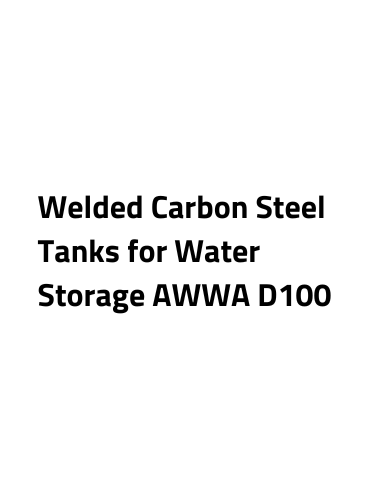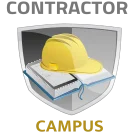 Welded Carbon Steel Tanks for Water Storage AWWA D100
Welded Carbon Steel Tanks for Water Storage AWWA D100
Welded Carbon Steel Tanks for Water Storage AWWA D100
Sections were revised to eliminate contractual language such as "purchaser shall..." and "constructor shall...". Several sections of the previous edition contained a mixture of requirements (i.e., material, design, welding, fabrication, erection, and inspection requirements). These requirements were segregated and moved to appropriate sections. ec. 1 was revised to require that specific anchorage details be provided when anchorage is required. Specific editions were added to the references. Only the editions specified are considered part of the standard. Sec. 3 was revised to align with the wind-load requirements of ASCE 7-02. Two new methods (Method 2 and Method 3) for determining the allowable local buckling compressive stress for shells were added. Method 3 permits an increase in the allowable stress due to pressure stabilization and is based on a nonlinear buckling analysis. Method 2 permits a partial increase in the allowable stress due to pressure stabilization. The existing method for determining the allowable local buckling compressive stress was renamed Method 1. Roof rafters designed using a roof live load of 50 lb/ft2 (2,400 N/m2) or less must be designed using allowable stresses for A36 material, regardless of the material used. Roof rafters designed using a roof live load greater than 50 lb/ft2 (2,400 N/m2) may utilize higher allowable stresses when using material with minimum specified yield strength greater than A36 material. Extensive requirements were added for anchor bolts and anchor straps. The thickness to which corrosion allowance is added was changed to the thickness determined by design for elements other than bottom plates of ground-supported flat-bottom tanks. A minimum width requirement was added for butt-welded annulus plates. The requirement that welded splices in tension bracing for multicolumn tanks must be designed for 100 percent joint efficiency was clarified. The 1/16-in. (1.59-mm) additional shell thickness requirement for flush-type cleanouts was eliminated to match the current requirements of API 650. Sec. 5 was revised to include the requirement that the inlet protection be removable. Recommendations for antennas and related equipment were added to Appendix A as commentary. Electrical isolation requirements were added for dissimilar metals inside the tank below the TCL. Sec. 6 (AWWA D100-96), entitled Sizing of Ground-Supported Standpipes and Reservoirs, was deleted. Sec. 7 was revised to include electrical isolation requirements for dissimilar metals inside the tank below the TCL. Sec. 8 was revised to increase the full-size proof test requirement for the qualification of welding procedure specifications for tension-bracing splice welds to 4/3 times the published minimum yield strength of the bracing member. Minimum fillet-weld size requirements relative to root opening were clarified and a maximum root-opening requirement (3/16 in. [4.76 mm]) was added. Seal-welding requirements for corrosion protection were also clarified. Sec. 10 was revised to clarify preheat requirements. Sec. 11 was revised to eliminate inspection based on sectional segments. The requirement that welds be visually inspected and acceptance criteria were added. Measurement and documentation requirements for shells designed by Method 2 or Method 3 were added. Qualification of welder and production testing requirements were added for tension-bracing splice welds. The proof test for tension-bracing splice welds was increased to 4/3 times the published minimum yield strength of the bracing material. Sec. 12 was revised to allow a one-third increase in the allowable bearing stress for wind loads when specified in the geotechnical report. Sec. 13 was revised to align with the seismic load requirements of FEMA 450 and proposed ASCE 7-05, which are based on a maximum considered earthquake ground motion for an event with a 2 percent probability of exceedance within a 50-year period (recurrence interval of approximately 2,500 years). General and site-specific procedures for determining design response spectra are included. Alternate procedures for elevated tanks and ground-supported flat-bottom tanks were added and allow the use of soil-structure and fluid-structure interaction. The requirement that P-delta effects be considered was added for all elevated tank styles. Vertical design acceleration requirements were specified and are now mandatory for all tanks. A critical buckling check for pedestal-type elevated tanks was added to guard against premature buckling failure. Equations were added to calculate the overturning moment for mat or pile cap foundations supporting flat-bottom tanks. Minimum freeboard requirements similar to those of ASCE 7-05 were added for ground-supported flat-bottom tanks. Piping flexibility requirements similar to those of ASCE 7-05 were added for all tanks. Appendix A, Commentary for Welded Carbon Steel Tanks for Water Storage, was added to provide background information for many of the requirements contained in the standard. Appendix B, Default Checklist, was added to assist users of the standard.
- SKU: r835
- Number of Pages: 278
- Publisher: AWWA (American Water Works Association)
- Genre: Educational
- Book Edition: 2021
- Alternate Name: Welded Carbon Steel Tanks for Water Storage - AWWA Standard, 2006, American Water Works Association, (800) 926- 7335, www.awwa.org

